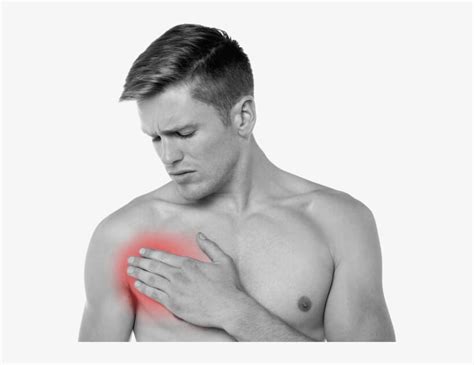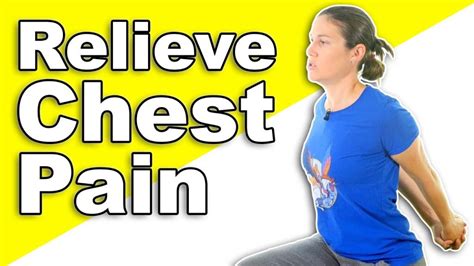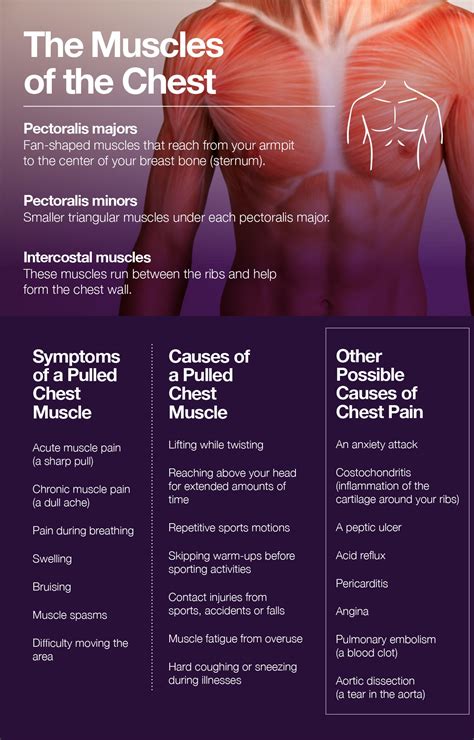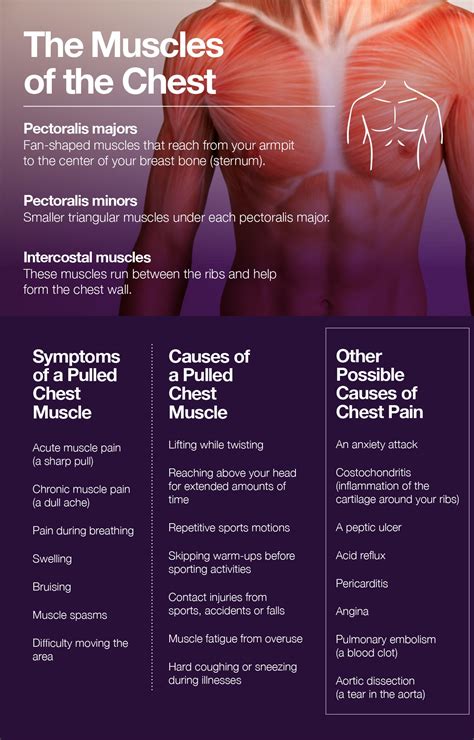Intro
Relieve chest muscle pain with 5 effective methods, including stretches, exercises, and self-care techniques to soothe sore pectoral muscles, costochondritis, and intercostal strain, promoting relaxation and pain management.
Chest muscle pain can be a debilitating and frustrating experience, affecting daily activities and overall well-being. The chest muscles, also known as the pectoralis muscles, play a crucial role in movement and stability, and any strain or injury can lead to discomfort and pain. Whether it's due to intense physical activity, poor posture, or underlying medical conditions, easing chest muscle pain is essential to regain comfort and mobility. In this article, we will explore the importance of addressing chest muscle pain, its common causes, and provide practical tips to alleviate the discomfort.
Chest muscle pain can manifest in various ways, from mild soreness to sharp, stabbing pain. It can be localized to a specific area or radiate throughout the chest, making it challenging to diagnose and treat. Ignoring chest muscle pain can lead to further complications, such as decreased range of motion, reduced strength, and increased risk of injury. Moreover, chest muscle pain can be a symptom of underlying conditions, such as costochondritis, tendinitis, or even heart problems, emphasizing the need for proper evaluation and treatment.
The good news is that most cases of chest muscle pain can be managed and alleviated with simple, non-invasive techniques. By understanding the causes of chest muscle pain and incorporating effective strategies, individuals can reduce discomfort, promote healing, and prevent future occurrences. In the following sections, we will delve into the world of chest muscle pain, exploring its causes, symptoms, and most importantly, providing practical solutions to ease the discomfort.
Understanding Chest Muscle Pain

To effectively address chest muscle pain, it's essential to understand its causes and symptoms. Chest muscle pain can result from various factors, including overuse or repetitive strain, poor posture, direct trauma, or underlying medical conditions. The symptoms of chest muscle pain can vary, but common complaints include dull aches, sharp pains, tenderness, and limited mobility. By recognizing the signs and symptoms, individuals can seek proper evaluation and treatment, reducing the risk of complications and promoting optimal recovery.
Causes of Chest Muscle Pain
Chest muscle pain can be attributed to several factors, including: * Overuse or repetitive strain: Engaging in activities that involve repetitive movements, such as weightlifting, rowing, or golfing, can lead to chest muscle strain and pain. * Poor posture: Slouching or slumping can put strain on the chest muscles, leading to discomfort and pain. * Direct trauma: A blow to the chest or a fall can cause chest muscle pain and bruising. * Underlying medical conditions: Conditions like costochondritis, tendinitis, or heart problems can cause chest muscle pain.5 Ways to Ease Chest Muscle Pain

Fortunately, there are several ways to ease chest muscle pain, from simple self-care techniques to professional treatments. Here are five effective methods to alleviate chest muscle pain:
- Apply Heat or Cold Therapy: Applying heat or cold packs to the affected area can help reduce pain and inflammation. Heat therapy, such as a warm bath or shower, can relax the muscles, while cold therapy, like an ice pack or cold compress, can numb the area and reduce swelling.
- Stretching and Foam Rolling: Gentle stretching and foam rolling can help alleviate tension and promote blood flow to the affected area. Focus on exercises that target the chest muscles, such as arm circles, shoulder rolls, and chest stretches.
- Strengthening Exercises: Engaging in strengthening exercises, such as push-ups, dumbbell presses, and chest presses, can help improve muscle strength and stability, reducing the risk of future strain and pain.
- Improve Posture: Maintaining good posture can help reduce strain on the chest muscles, alleviating pain and discomfort. Make sure to stand or sit up straight, with shoulders back and chest open.
- Seek Professional Help: If chest muscle pain persists or worsens, seek professional help from a healthcare provider or physical therapist. They can provide personalized guidance, treatment, and rehabilitation to promote optimal recovery and prevent future occurrences.
Additional Tips for Chest Muscle Pain Relief
In addition to the above methods, consider the following tips to alleviate chest muscle pain: * Take regular breaks to stretch and move, especially during prolonged periods of sitting or standing. * Avoid heavy lifting or bending, which can exacerbate chest muscle strain. * Wear comfortable, supportive clothing and shoes to reduce strain on the chest muscles. * Practice stress-reducing techniques, such as deep breathing, meditation, or yoga, to help manage stress and promote relaxation.Chest Muscle Pain Prevention

Preventing chest muscle pain is crucial to maintaining optimal health and mobility. By incorporating simple strategies into daily life, individuals can reduce the risk of chest muscle strain and pain. Here are some effective ways to prevent chest muscle pain:
- Engage in regular exercise, such as cardio, strength training, and flexibility exercises, to improve overall muscle strength and flexibility.
- Maintain good posture, avoiding slouching or slumping, to reduce strain on the chest muscles.
- Take regular breaks to stretch and move, especially during prolonged periods of sitting or standing.
- Avoid heavy lifting or bending, which can exacerbate chest muscle strain.
Chest Muscle Pain and Overall Health
Chest muscle pain can have a significant impact on overall health and well-being. Chronic chest muscle pain can lead to decreased mobility, reduced strength, and increased risk of injury. Moreover, underlying medical conditions, such as costochondritis or heart problems, can cause chest muscle pain, emphasizing the need for proper evaluation and treatment. By addressing chest muscle pain and incorporating preventative strategies, individuals can promote optimal health, mobility, and overall well-being.Chest Muscle Pain Treatment Options

If chest muscle pain persists or worsens, seeking professional help is essential. A healthcare provider or physical therapist can provide personalized guidance, treatment, and rehabilitation to promote optimal recovery and prevent future occurrences. Treatment options may include:
- Physical therapy: A physical therapist can help improve range of motion, strength, and flexibility, reducing pain and discomfort.
- Medications: Over-the-counter pain relievers, such as acetaminophen or ibuprofen, can help alleviate pain and inflammation.
- Alternative therapies: Acupuncture, massage, or chiropractic care can help reduce pain and promote relaxation.
When to Seek Medical Attention
While most cases of chest muscle pain can be managed with self-care techniques, there are instances where medical attention is necessary. Seek medical help if: * Chest muscle pain is severe or persistent. * Pain radiates to the arms, back, or jaw. * Shortness of breath, dizziness, or lightheadedness accompanies chest muscle pain. * You experience difficulty swallowing or breathing.Conclusion and Next Steps

In conclusion, chest muscle pain is a common complaint that can be managed and alleviated with simple, non-invasive techniques. By understanding the causes and symptoms of chest muscle pain, individuals can take proactive steps to prevent and treat the condition. Remember to prioritize self-care, maintain good posture, and seek professional help if necessary. With the right approach, it's possible to ease chest muscle pain, promote optimal recovery, and prevent future occurrences.
We invite you to share your thoughts and experiences with chest muscle pain in the comments below. Have you tried any of the methods mentioned in this article? What worked best for you? Share your story and help others who may be struggling with chest muscle pain.
What are the common causes of chest muscle pain?
+Chest muscle pain can be caused by overuse or repetitive strain, poor posture, direct trauma, or underlying medical conditions such as costochondritis, tendinitis, or heart problems.
How can I alleviate chest muscle pain at home?
+You can alleviate chest muscle pain at home by applying heat or cold therapy, stretching and foam rolling, and engaging in strengthening exercises. Maintaining good posture and taking regular breaks to stretch and move can also help.
When should I seek medical attention for chest muscle pain?
+You should seek medical attention if chest muscle pain is severe or persistent, radiates to the arms, back, or jaw, or is accompanied by shortness of breath, dizziness, or lightheadedness.
